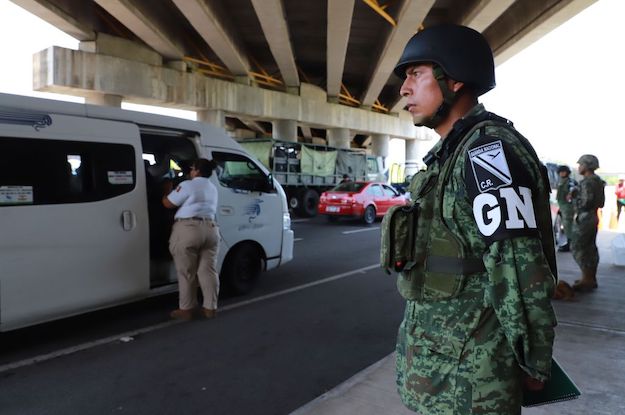Both Andrés Manuel López Obrador and Donald Trump have hailed their immigration deal as a victory. But as more details of the agreement come to light, it appears that Trump may have gotten far more out of it than López Obrador – and that the Mexican government may find itself going down a path it can’t control, with consequences that Mexicans do not yet fully understand.
Mexico and the U.S. need to adopt a longer-term approach if they hope to solve their respective migration challenges. The number of migrants reaching the U.S. border started to climb last August and skyrocketed in the early months of this year; apprehensions reached 132,887 in May, compared to just 40,339 in the same month a year ago. The overwhelming majority of these migrants are from Guatemala and Honduras, and mostly traveling in families, although there are also nationals of El Salvador, Nicaragua, Mexico, Cuba, Haiti, Venezuela, and several African and Asian countries.
It is hard to peg this sudden rise in migration to specific circumstances in Central America, although the situation there has been dire for a long time, both in terms of public security and economic conditions. The most likely causes of the spike in migration are so-called caravans in which large groups of migrants have begun to travel through Mexico together. This created an existential threat to migrant smugglers, who feared that the caravans would replace them as the preferred means of migration.
Caravans forced smugglers to offer far more accessible options for taking people to the United States, such as express buses that cut down on the length of the journey, less expensive rates for families that migrate together, and credit schemes for those who don’t have money on hand for the trip. At the same time, growing awareness in Central America that the U.S. government would not detain families for long, and that they could apply for asylum and remain in the United States for years while their case is heard, also contributed to the rise.
In short, Central Americans today have many more options for migrating, thanks to the smugglers’ creativity, and a far better chance of staying in the United States if they do, thanks to the way the U.S. asylum system operates.
Trump, enraged by the rising numbers — and perhaps by a specific incident in which over a thousand migrants crossed into the United States at once — has pressured Mexico to commit to boosting its efforts to stop the flow of migrants through its territory. As part of the agreement, the Mexican government is reinforcing its immigration controls by deploying 6,000 National Guard units to the southern border and going after smuggling organizations more aggressively.
Mexico is also increasing its cooperation with a program called Migrant Protection Protocol (MPP), which requires asylum seekers who cross the border into the United States to return to Mexico while they wait for their case to be heard. The Trump administration hopes to discourage asylum applications by forcing migrants back across the border, but the measure has obvious downsides for local communities in Mexico that may soon find themselves hosting tens of thousands of Central Americans and other migrants who are waiting in limbo for months for their U.S. asylum hearings.
In the short term, it is possible that increased enforcement at Mexico’s southern border and quick strikes against some of the smuggling organizations may deter some of the migration from Central America. Both Trump and López Obrador are counting on that.
However, this is far from being a long-term strategy, which would require that both governments begin to fix structural problems in their own immigration and asylum policies.
The Mexican government desperately needs to invest in a well-resourced, well-structured, and well-controlled National Immigration Institute (INM) that can do both border control and visa policy, as well as an asylum system that can handle the tens of thousands of applications that the country receives each year. The Mexican government could take pressure off the U.S. border in a humane way, consistent with the approach that López Obrador says he wants to implement, by creating employment-based visas and temporary worker programs for Central Americans and providing asylum to those fleeing from violence in the countries next door.
Meanwhile, the U.S. government needs to fix its own asylum system, so that decisions are rendered in weeks rather than years. That would be fairer to those fleeing violence and serve as a deterrent to those who do not qualify and would be returned quickly to their home countries. This could be done relatively quickly by taking asylum decisions away from overburdened immigration courts and handing them to trained asylum officers, something the administration could do if it wanted to. An efficient asylum system would quickly reduce the ease with which people can arrive and remain in the United States if they do not have a strong case for protection.
Unfortunately, the U.S. government would rather put the burden of immigration control mostly on Mexico, and the Mexican government seems willing to acquiesce. Both sides have reportedly agreed that if current efforts do not work, then they will move towards a Safe Third Country agreement, which would require migrants to seek asylum in Mexico if they cross through the country on their way to the United States.
In principle, a Safe Third Country agreement, especially if implemented regionally with other countries participating, and gradually with a slow rollout over several years, makes some sense. It would mean that asylum seekers need to request asylum in the first safe country they reach, and countries like Guatemala, Panama and Brazil, which are entry points for different migration flows, would have to participate.
In reality, of course, most of these countries, including Mexico, are a long way from having operable asylum systems that can accommodate all the requests that they would receive under such an arrangement. They are also far from being safe countries for those who seek asylum in the first place. So it is an interesting idea to build towards, and it might be possible to start laying the foundations of an arrangement like this, but it would almost certainly fail if the U.S. and others tried to implement such an arrangement over night, as the Trump administration would like to do. It is worth noting that the European Union tried a similar arrangement, which collapsed almost immediately when large-scale Syrian flows started in 2015. Regional asylum systems only work when they are implemented gradually and with the right incentives in place.
For now, the U.S. and Mexican governments seem focused almost entirely on the short-term objective of slowing migration flows to the shared border, with Mexico assuming the role of buffer state for the United States. There is a chance that this sudden injection of energy and resources into border control in Mexico will work in the short-term to reverse the trend of rising unauthorized migration to the United States. But it is unlikely to be a permanent solution if the two governments do not do their homework and make policy changes to ensure that their asylum systems work effectively and that Mexico begins to develop its own long-term immigration policies and institutions.
—
Selee is president of the Migration Policy Institute








